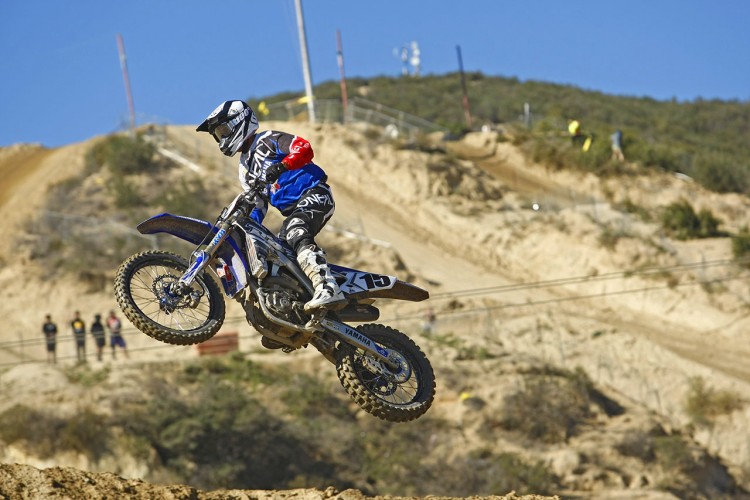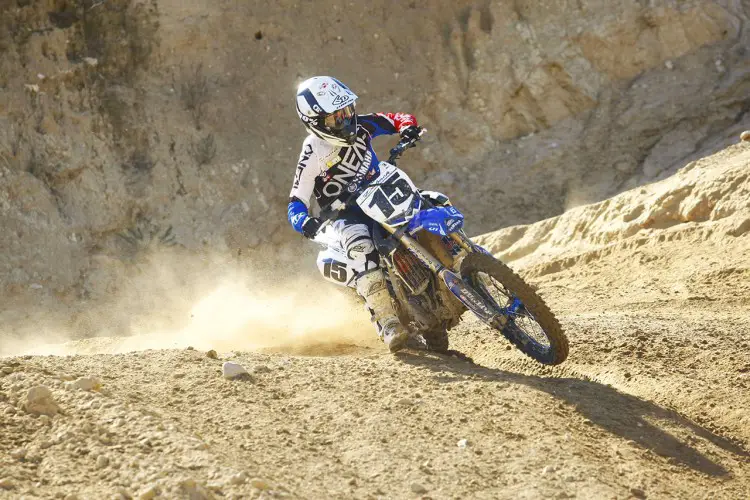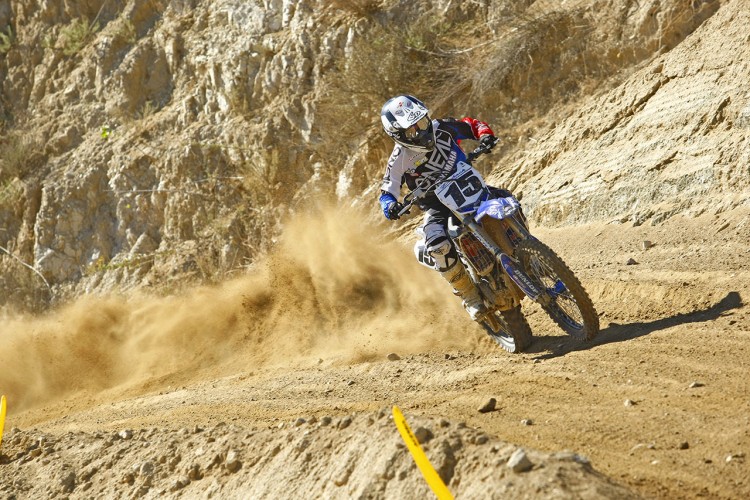INTERVIEW OF THE WEEK: DOUG DUBACH
Click on images to enlarge
AMA Supercross winner, motorcycle test rider, entrepreneur and father to three, Doug Dubach has many claims to fame. Of course there’s also the growing number of World Vet Championship titles, which makes Doug the fastest Vet on the planet.
I sat down with Doug on the eve of the 31st annual Dubya World Vet Championships to talk about everything from his factory Yamaha days to developing the first modern four-stroke and what is the single biggest flaw in riding technique. Then, on Sunday, Doug won his 25th World Vet Championship. That list includes titles in the Over-30, Over-40 and Over-50 classes (often two different age-group Championships in the same year).
Do you think your career would have been different if you hadn’t won the San Jose Supercross in 1991? I don’t think it would have been much different. I think it did open a few doors for me, but that win was late in my career. It’s not like it was early enough to make a big difference.
Having been teammates with Damon Bradshaw at factory Yamaha, was Damon a different person behind closed doors than he was in public? Yes. Damon was a good guy deep down inside. He loved to ride his motorcycle, much like the rest of us. Unfortunately, there was a lot of extra pressure on him. As a phenom at such a young age, he was expected to be great. The worst thing he did was win a Supercross race in Japan when he was barely 16 years old. He beat Ricky Johnson, Jeff Ward, and a lot of the best guys in the sport. It set him up for failure in a sense. He had nowhere to go, and it was hard to continue that sort of dominance. He certainly had a few personality flaws. Damon’s mental side was his strongest piece, as well as his worst attribute. He allowed himself to get too wrapped up and disturbed about things that were going on around him. It was great being Damon’s teammate, because I was the antidote to his chaos. I would try to keep his direction going on the right path. I know it extended my career. Jeff Emig was a bit of a loner at Yamaha. He didn’t hang out with the team very much, and he was only at Yamaha for a few years. I fit in as Damon’s father figure, and I had enough experience under my belt that Damon would listen to me.
“SOMEONE REALLY SHOULD WRITE A BOOK ON THOSE DAYS WITH ALL OF THE ANTICS AND THINGS WE SHOULD HAVE GONE TO JAIL FOR. THOSE STORIES ARE STILL HAPPENING, BECAUSE RACERS ARE GUYS WHO LIVE ON ADRENALINE. THAT’S THE PATH YOU CHOOSE, AND YOU FIND YOURSELF IN CIRCUMSTANCES WHERE YOU NEED A RELEASE FROM THE DANGEROUS ENVIRONMENT YOU’RE CONSTANTLY LIVING IN.”
Back in those days it wasn’t uncommon for racers to do questionable things, like wreck rental cars and things along those lines. Do you have a funny story involving Damon Bradshaw? [Laughter] There’s one that really stands out. One time we had done an autograph signing and left for the hotel. Damon, Shaun Kalos, Mike LaRocco and I were in the car, and one of us forgot something at the dealership. I was driving and Damon was in the passenger seat working the hand brake. We ended up putting a pretty good dent in the side of our rental car. It scared LaRocco half to death, because we hit the passenger rear door where he happened to be sitting. There’s a lesson to be learned, and it’s that you should never let two separate people work the steering wheel and the hand brake [laughter].
Another funny story is that a younger rider was talking recently about the Red Bud National and driving around that area. He didn’t even get the next sentence out before I butted in and said, “You’re talking about the rental car jump behind the grocery store, aren’t you.” He looked at me with this crazy expression and said, “How could you possibly know that?” I told him that I was at Red Bud 30 years before him. Damon and I had hit that same jump in the parking lot way back when. I was stupid enough to be in the passenger seat holding the video camera while Damon drove. We jumped so high that I smacked my head against the roof, and the next day I raced Red Bud with a stiff neck [laughter]. Someone really should write a book on those days with all of the antics and things we should have gone to jail for. Those stories are still happening, because racers are guys who live on adrenaline. That’s the path you choose, and you find yourself in circumstances where you need a release from the dangerous environment you’re constantly living in.
 Has the racing lifestyle changed? The glamor is certainly bigger, because now there is the television package and outside sponsors. The part I don’t see these days is the camaraderie of the riders. They pit themselves against one another on the race track, but they don’t seem to talk much. I remember one year when I was racing the Hangtown National. It was back in the box van days. I was sitting on the bumper of Jeff Stanton’s Honda box van talking to Jeff Ward and Broc Glover. We all interacted a lot more than today’s racers. Now some of them have their personal motorhomes to hide in. There’s a much different feel at the races these days. I always have to fight for my pass, and then I can’t go some places. Obviously they have to polish things up for television, but something is lost along the way.
Has the racing lifestyle changed? The glamor is certainly bigger, because now there is the television package and outside sponsors. The part I don’t see these days is the camaraderie of the riders. They pit themselves against one another on the race track, but they don’t seem to talk much. I remember one year when I was racing the Hangtown National. It was back in the box van days. I was sitting on the bumper of Jeff Stanton’s Honda box van talking to Jeff Ward and Broc Glover. We all interacted a lot more than today’s racers. Now some of them have their personal motorhomes to hide in. There’s a much different feel at the races these days. I always have to fight for my pass, and then I can’t go some places. Obviously they have to polish things up for television, but something is lost along the way.
You were on the ground floor of the modern four-stroke movement at Yamaha. That has to be one of the coolest jobs ever. What advice can you give to someone who dreams of becoming a motorcycle test rider? I was lucky. I grew up a drag racer’s son and arguably a poor boy who bought used bikes and had to fix them myself. I’m not telling anyone that their goal should be to end up poor and buy used bikes. I was just fortunate enough to be around a lot of smart people that did things with their hands. I could weld when I was 10 years old. If you have any ambitions to do a job like that, make sure you’re intelligent and can also ride a motorcycle. You don’t have to be the top Pro-level racer. Experience is what counts. Your riding level is only a smart part of it. It’s important to understand mechanical things and how they work. You also need to recognize if something is good or bad, and whether it made a change to performance. It can be a fairly complex job, but it is one of the best jobs that I’ve ever had. I’ve cleaned pools, mowed lawns, done brakes on vehicles, and everything in my early years to pay for my racing. I feel so fortunate to be the pioneer in the modern-day four-stroke boom. I rode the very first prototype bikes. To be on the leading edge of four-stroke development, and the 250 four-stroke, was uncharted territory. I’ll always have that to take with me for as long as I live. I was deep in the trenches in the progression and transition of motocross.
Has technology evolved to the point that consumers cannot grasp the intricacies of how a motorcycle works? There are some things that have taken away the simplicity of a dirt bike. You can no longer change a pilot jet or simply rebuild a two-stroke top end. Some of that stuff is just the evolution of the machine. Air forks are a different topic, because they’re driven by cost and weight reduction. Complexity is one of the biggest downfalls of air forks. There are also some shortcomings in performance. The average guy, as you point out, isn’t super intelligent. He wants to ride his dirt bike because he likes riding his dirt bike. Very few are intellectual with a lot of background and knowledge. The air fork does pose extra work for most riders. I’m at the track all of the time, so I hear the pros and cons of air forks. The biggest complaint I hear is that people have a hard enough time checking their tire pressure and every other thing, and that they don’t want to check their fork pressure. Maybe they’ll have some solution in five years from now. There has to be some solution. As much as air forks are being pushed by the manufacturer because of cost and weight reduction, the consumer is starting to push back.
 Are you surprised that two-strokes are making a resurgence in popularity? Surprise certainly wouldn’t come out of my mouth. I’ve loved two-strokes from day one, and I have been the guy internally at Yamaha who has fought to keep the two-stroke alive. Some of the other brands found a direction or were too lazy to fight, and they let their two-stroke lines go away. There is no argument that if you have to go out and win a race or a title, a four-stroke is the bike to choose. To me, pouring two-cycle oil into some gas and riding is one of my favorite things to do. Two-strokes are lightweight, aggressive, and everything that a certain demographic looks for in a bike. I hope and pray that two-strokes never go away, at least not in my lifetime. I’m definitely not surprised two-strokes are around, and I applaud the companies that are still making them.
Are you surprised that two-strokes are making a resurgence in popularity? Surprise certainly wouldn’t come out of my mouth. I’ve loved two-strokes from day one, and I have been the guy internally at Yamaha who has fought to keep the two-stroke alive. Some of the other brands found a direction or were too lazy to fight, and they let their two-stroke lines go away. There is no argument that if you have to go out and win a race or a title, a four-stroke is the bike to choose. To me, pouring two-cycle oil into some gas and riding is one of my favorite things to do. Two-strokes are lightweight, aggressive, and everything that a certain demographic looks for in a bike. I hope and pray that two-strokes never go away, at least not in my lifetime. I’m definitely not surprised two-strokes are around, and I applaud the companies that are still making them.
You’re 52 years old, but age hasn’t slowed you one bit. What is your speed secret? I started late as a rider. I didn’t have a bunch of pressure as a kid and didn’t have to deal with all of those things that turn people off to racing. I did it solely on my own. My father was in a wheelchair, so I was only introduced to dirt bikes when I was 14 years old because of my brother. I come from a very different place. I ride for the enjoyment of riding. I was never forced to ride. The other part of the equation is that I try to focus on the technical aspect of riding. If I was as technically good as a Pro as I am now, then I would have had far more success as a professional racer. With that, I skirt the odds in my favor with injuries and things that make people stop riding. I have been a Yamaha test rider for over 30 years, and I’ve almost been with Dunlop for that long. I run my own company that develops performance exhausts, so I’m always on a bike. How you maintain something is that you never get too far away from it. I didn’t stop riding for ten years because I got married and had kids. I’ve been able to somewhat remember what it was like to ride and how to get it done. I was never an AMA Champion, but I stood on the podium quite a few times and I held on to a factory ride for a lot of years.
“SO MANY RIDERS DON’T UNDERSTAND HOW TO APPROACH A CORNER. A PHYSICS MAJOR WOULD EXPLAIN IT TO YOU IN A VERY SIMPLE WAY. ITS ALL ABOUT VEHICLE SPEED AND LEAN ANGLE–NO MORE OR NO LESS THAN THAT. IF YOU CAN GET THE LEAN ANGLE TO MATCH YOUR VEHICLE SPEED, THEN YOU’RE GOING TO GO THROUGH A CORNER EFFORTLESSLY. THE ONLY WAY TO REALLY GET A VEHICLE AT A NICE CONSTANT, FROM THE ENTRANCE THROUGH THE EXIT, IS TO FINISH USING THE BRAKES EARLY. LEARN HOW TO DEAL WITH A COASTING MOTORCYCLE.”
What gave you the idea to start Dubach Racing? It’s a funny story. I blame my wife. I was doing a lot of work for a lot of other people, and I was racing for White Brothers. At the same time, I was doing development for another exhaust brand in the industry. I was so frustrated with their knowledge and enthusiasm about the four-stroke. I knew that four-strokes were the future. The White Brothers didn’t have a good understanding, and they were really focused on using a dyno to develop their pipes. Another company was so fixed on two-strokes that they didn’t think four-strokes would ever make a dent in motocross. I remember coming home one day and complained to my wife about how no one knew how to build four-stroke exhausts. She told me that I should build my own pipes. I laughed at her, because I was just a dirt bike guy. I didn’t know how to run a company and I didn’t have a business background. Yet a few weeks later I filed for a business license. I had a good friend of mine who was a high-level engineer. He worked on the technical side, and I was the seat-of-the-pants tester. We ended up winning just about every pipe shootout we entered. My philosophy is to test my products by riding with them at the track. Bench testing is a piece of the puzzle, but it’s not how you develop a product. It comes down to real humans with real feelings and real abilities to make a product as good as it can be. We’re still not a big company, but I believe we have very good product. I wish I had a lot more money to market and advertise like some of my competitors. Maybe it would be a different story, but that’s not the case.
Finally, what’s the one piece of riding advice you can offer to the vast majority of racers? Rear brake usage is probably the biggest thing. I was a felon in the rear-brake-dragging category in my younger years. So many riders don’t understand how to approach a corner. A physics major would explain it to you in a very simple way. It’s all about vehicle speed and lean angle–no more or less than that. If you can get the lean angle to match your vehicle speed, then you’re going to go through a corner effortlessly. The only way to really get a vehicle speed at a nice constant, from the entrance through the exit, is to finish using the brakes early. Learn how to deal with a coasting motorcycle. When you can master that and get really good at finishing your braking, leaning the bike and traveling through the corner at a fast and consistent speed, then you’ll crush your competition. I don’t do very many motocross schools, but I do enjoy working with riders. Rear brake usage is the single biggest thing I notice from riders, and it’s great to see that light go off in their head when they figure out how to coast through corners without hitting the rear brake. It’s truly about physics. If you’re going to take an object with two wheels and get it around a radius, then you’re going to have to lean it over. You’re going to fall over if you’re not going fast enough. You have to get that lean and that speed matched up, and then it all ties together.






Comments are closed.